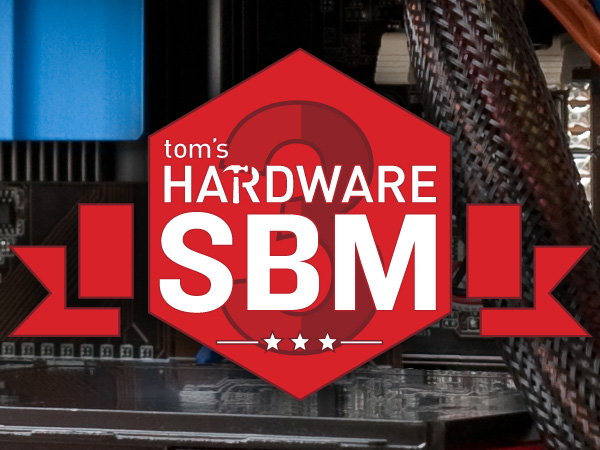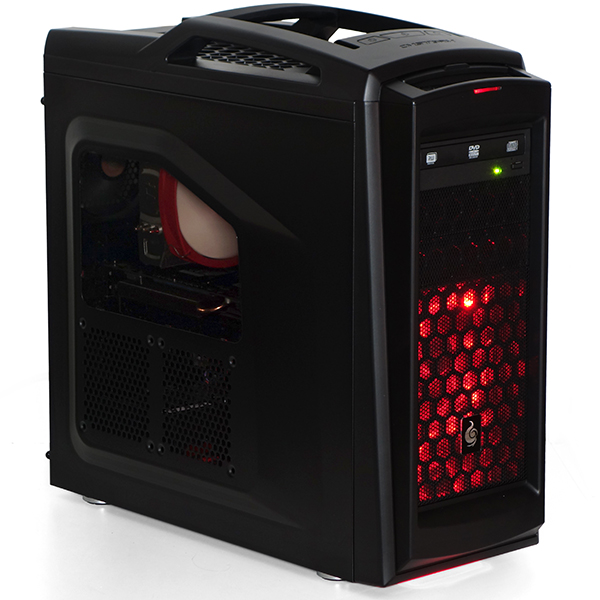System Builder Marathon, Q2 2014: A Balanced High-End Build
Can A $1600 PC Really Be High-End?

System Builder Marathon, Q2 2014: The Articles
Here are links to each of the four articles in this quarter’s System Builder Marathon (we’ll update them as each story is published). And remember, these systems are all being given away at the end of the marathon.
To enter the giveaway, please fill out this SurveyGizmo form, and be sure to read the complete rules before entering!
Day 1: The Budget Gaming PC
Day 2: Our Mainstream Enthusiast System
Day 3: The Balanced High-End Build
Day 4: Performance And Value, Dissected

Redefining The SBM Brackets
As you've seen over the past two days, Paul, Don, and I pored over feedback and made some changes to this quarter's System Builder Marathon, which we hope reflects more of what you'd like to see.
Perhaps the most frequently-requested update, readers asked that we narrow the entire range to make this a closer competition. So, rather than multiplying Paul's baseline ~$600 machine by 2x and 4x, which used to result in Don's $1200 system and my $2400 config, we dropped back to 2x and 3x ($1200 and $1800). That was complicated by another move: we added operating systems to our cost considerations.
And so the arguments between builders began. If the $600 PC only had $500 worth of hardware, shouldn't the price range for parts be $500, $1000, and $1500? Then, the original debate that $600, $1200, and $1800 budgets should include Windows turned into a compromise. We'd hold the hardware down at a lower target, and make a distinction between components that affect performance and everything else (like the chassis and optical drive).
Get Tom's Hardware's best news and in-depth reviews, straight to your inbox.
This would supposedly give me the flexibility to splurge on a fancy case and Blu-ray drive without getting slaughtered in the value competition. But wait, doesn't a case directly affect the cooling system? Isn’t overclocking a vital part of our overall analysis?

As a case reviewer, I know that anyone leaning on a large radiator for liquid cooling has to shop for a chassis able to accommodate the extra equipment. I also know that cases with multiple fans typically cost more than similar enclosures without. So, I went back to the original formula: $1500 should buy everything except for Windows.
| Q2 2014 $1600 Performance PC Components | ||
|---|---|---|
| Processor | Intel Core i7-4770K: 3.5 GHz base (3.9 GHz max. Turbo Boost), Quad-core, 8 MB shared L3 cache | $320 |
| Graphics | PowerColor PCS+ AXR9 290X 4GBD5-PPDHE Radeon R9 290X | $529 |
| Motherboard | Asus Z97-A: LGA 1150, Intel Z97 Express | $150 |
| Memory | G.Skill Ripjaws X F3-14900CL8D-8GBXM: DDR3-1866 C8, 8 GB (2 x 4 GB) | $85 |
| System Drive | Samsung 840 EVO MZ-7TE250BW: 250 GB, SATA 6Gb/s SSD | $150 |
| Power | Rosewill HIVE-750: 750 W Semi-Modular, ATX12V v2.3, 80 PLUS Bronze | $90 |
| CPU Cooler | Thermaltake NiC L32 (CL-P002-AL14RE-A) 140 mm | $38 |
| Platform Cost | $1362 | |
| Storage Drive | WD Blue WD10EZEX: 1 TB, SATA 6Gb/s Hard Drive | $60 |
| Optical | Lite-On iHAS124-04: 24x DVD±R, 48x CD-R | $20 |
| Case | CM Storm Scout 2 Advanced | $90 |
| Total Hardware Cost | $1532 | |
| OS | Windows 8.1 X64 OEM | $100 |
| Complete System Price | $1632 |
After compiling my list of parts, I was at $1472 without a hard drive or operating system, and ready to place my order. After all, my SSD was large enough that I didn’t need to split games and applications between two drives. I likewise would have preferred a better CPU cooler or Blu-ray drive, but any step up would have put me over $1500.
Eventually, I let the guys talk me into adding a 1 TB drive using the logic that only the parts affecting performance would go into the value calculation, and my mechanical disk drive wouldn't be included. In fact, I wouldn't even need to format my extra hard drive to complete our benchmark suite.
And so I stand alone, with a system that was supposed to cost $1472 of my $1500 hardware budget, and a nod to whoever wins this PC; it has an extra storage drive so you won't have to rely on a 250 GB SSD for all of your movies, music, and documents.
Rather than continuing to argue, I'm listing the complete platform price that they want to use in the value analysis, the total hardware cost that we previously used in our value analysis, and a complete system price (including the operating system). The best part is that I'm the one who gets to divvy-up prices for the various value charts for tomorrow's value shoot-out.
Conversely, as the “big-budget builder”, I’m also forced to make this quarter’s $1532 hardware compete with the previous quarter’s $2400 configuration. I do have one small ace in the hole, though. You may have noticed yesterday that Don's graphics card of choice went up in price, but comes with a free 250 GB Samsung 840 EVO. It just so happens that's the exact SSD I bought for this system back in May. If you don't mind paying $40 more for the PowerColor card in my build, for the next few days it also includes a bundled 250 GB 840 EVO. That $40 expense saves $150. You'd need to hurry though; PowerColor reps say the sale is only on through the end of June.
Current page: Can A $1600 PC Really Be High-End?
Next Page CPU, Graphics, And Memory-
mrmike_49 Only 8GB RAM for a high end PC? Just plain too much money spent on graphics card. Also, too much money spent on "yuppie" power supply/caseReply -
de5_Roy thermaltake nic L32 doesn't seem well suited for the cpu for stock operations. at stock settings, the cpu's load temp is 57c over ambient according to the temp. chart. the q1 $1600 pc has a hyper 212 evo and it ran the stock i7 4770k under 40c over ambient. from the looks, the tt nic cooler seemed a better performer than the hyper 212 evo.Reply
was multicore enhancement enabled for both the q1 $1600(asrock z87 pro3) and this quarter's high end pc(asus z97-a)? did it affect the heat output? asus keeps m.c.e. enabled by default. i can't see any other factors atm.
all 3 builds look very well-performing this quarter. looking forward to the perf-value analysis. -
Taintedskittles Reading the reviews on newegg about that PowerColor 290x you chose was hilarious. So whoever win's this thing can look forward to many many rma's in the future. Apparently its plagued with artifacts, bad fans, bios issues, & performance degradation. I would have chosen another brand at the very least.Reply -
pauldh To be fair though, look at the dates of those negative Newegg reviews. All but one of the complaints appeared after this system was ordered mid-May. Prior available feedback WAS almost all positive. And a manufacturer rep jumped in to resolve that one.Reply
-
Crashman Reply
A yuppie power supply...OK...13586826 said:Only 8GB RAM for a high end PC? Just plain too much money spent on graphics card. Also, too much money spent on "yuppie" power supply/case
The last time I checked the "Samsung 840 EVO MZ-7TE250BW" wasn't an HDD, and nobody wanted us to run OS/2 on a modern gaming system. Please read the charts, wabba13587011 said:kidding me, hdd and windows 8, pls, read up on hardware toms hardware.....and software.
-
crisan_tiberiu Make this "competition" global please... :( You have "Tom's Hardware" in every major region in the world... :) Also FedEx and DHL ships everywehere in the world :) make all readers happy :) Our traffic is good for your site, but we never get something special :((Reply -
rush21hit If I had a specs like this, I don't want it to be encased. I'd stick it to my wall even if it means I had to figure out how to do it.Reply -
Realist9 I think the author hit his mark for the intent of the build/article based on the budget limit and provides a good starting point for us. However, if I was actually building and buying for myself, I would make some changes to add headroom and compatibility.Reply
I would go with 16 GB of memory for $85 more, since that’s only $85/$1600=5% more cost. I’d also go ahead and get the Asus 780 for $520. (Side note: I disagree that most would go AMD in a 780 vs 290x, but I know better than to open that can of worms). SLI was mentioned but not used, and I also would not get SLI unless I KNEW it worked with the game I was most interested in. The posts on various forums about SLI causing problems in most games, along with SLI “issues” dating back to 3dFX Voodoo2 cards, keeps me away from SLI.
I also would stay away from “generally stable, but usually not stable in the games I want to play most” (not quoting the author here) overclocking of the system/video card. It’s nice to see it in the charts, but I read about way too many problems in games caused by overclocking for me to rely on it to get my ‘value’.
Lastly, I think the pendulum has swung too far towards “value” for the high end build. I suggest tweaking that a little for future high end builds (eg..780Ti, 16 GB memory, 500GB SSD, but continue to stay away from $1000 CPU, $1200 SLI, etc).
